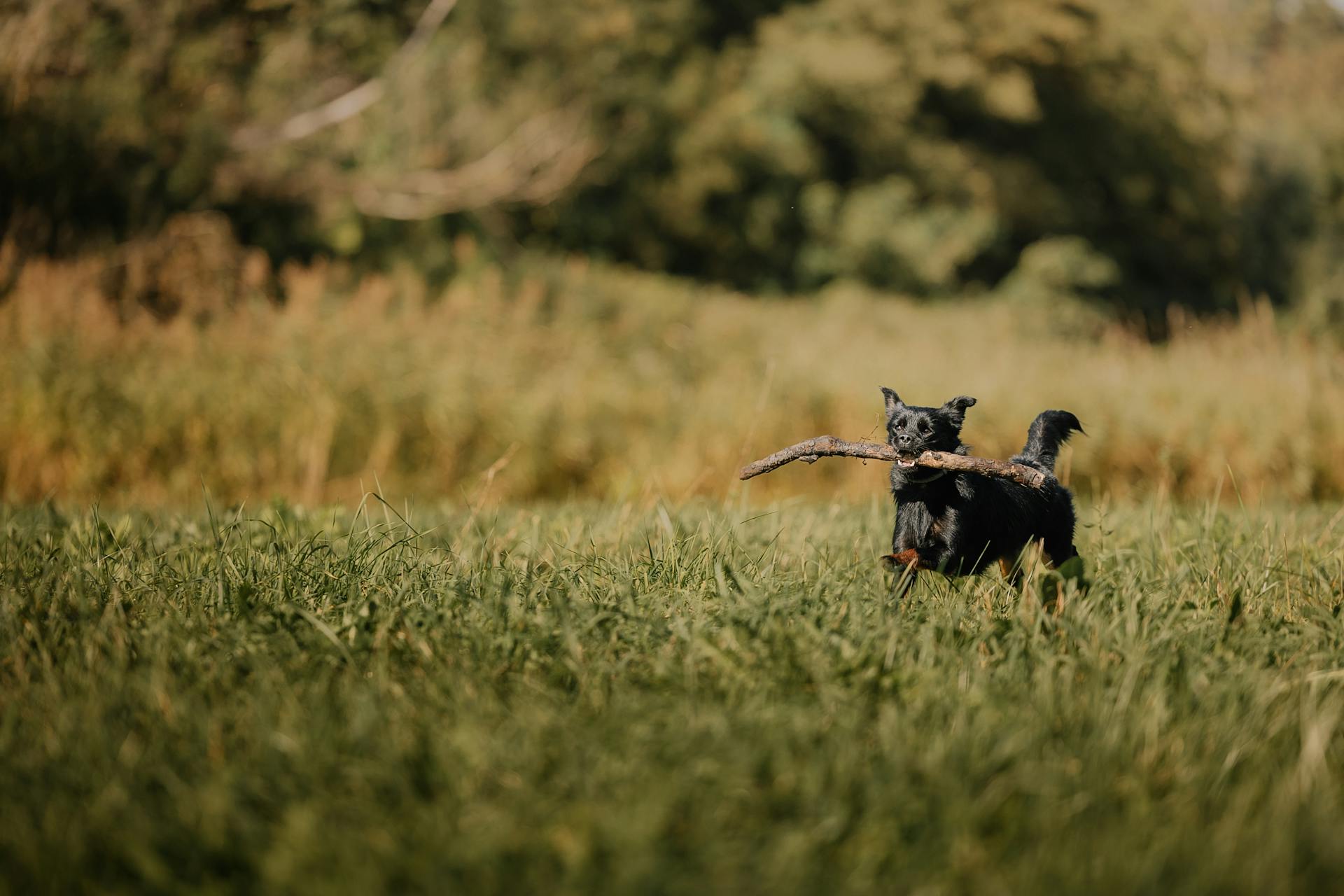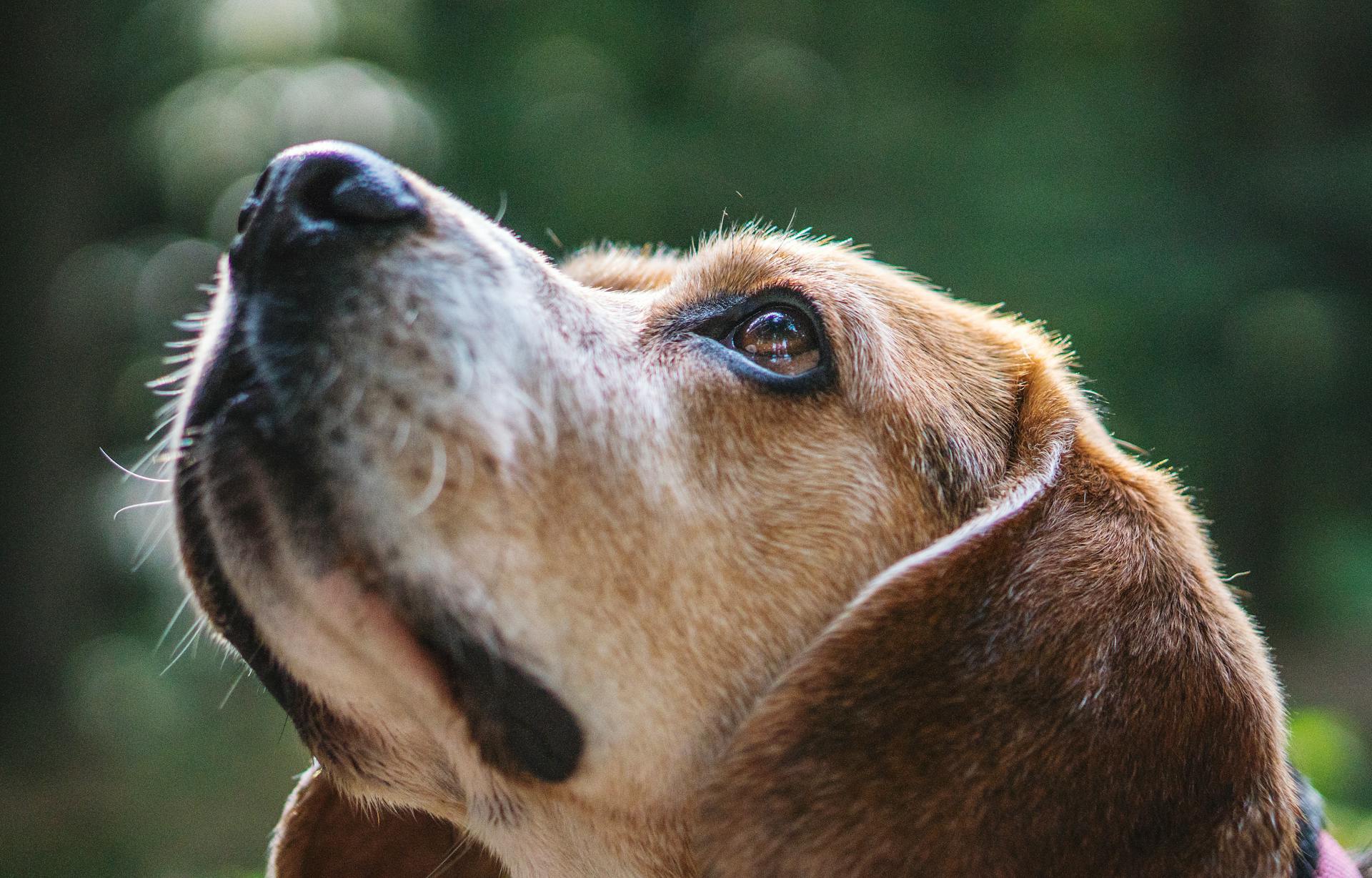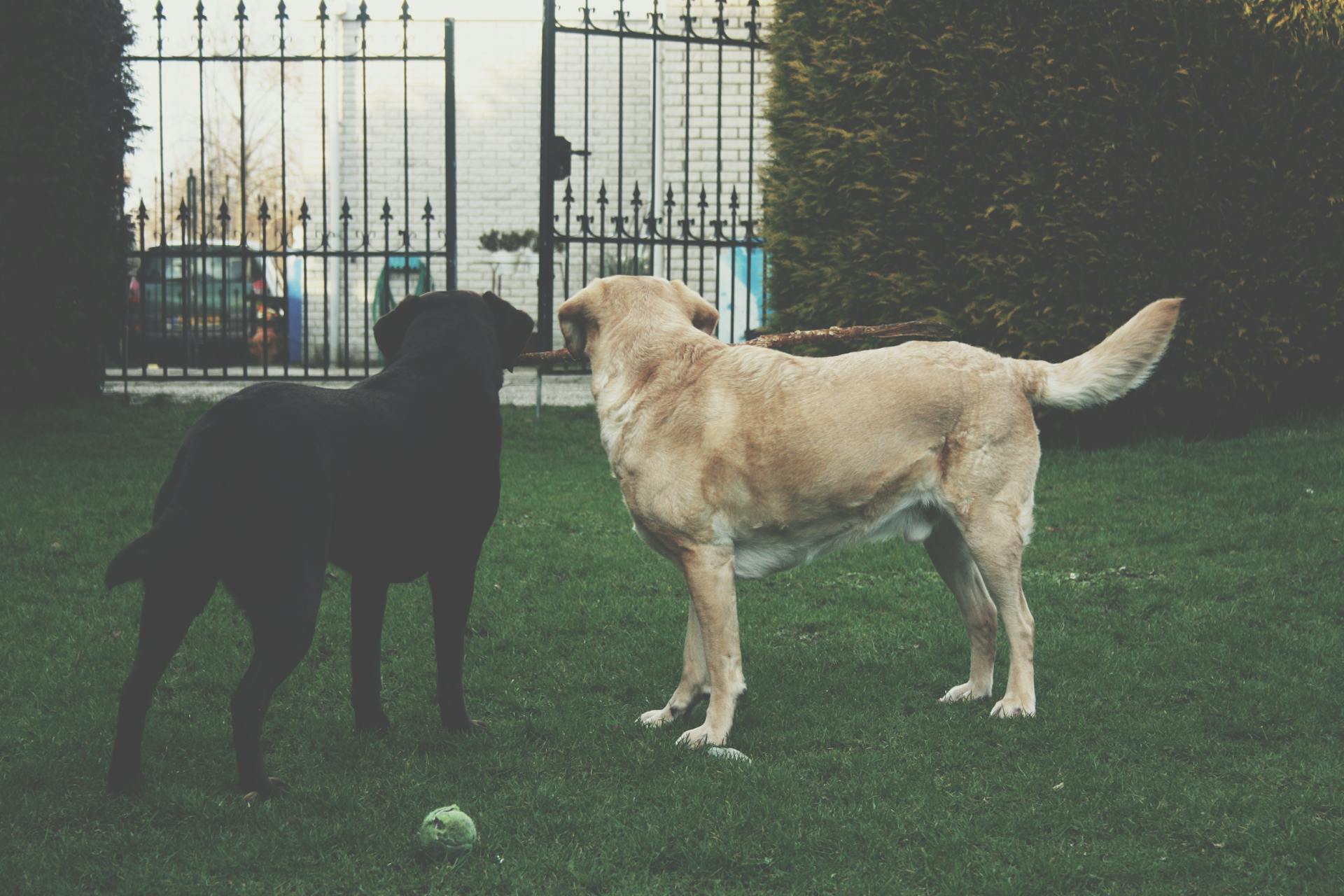
Fear periods in dogs can be a challenging time for both dogs and their owners. They occur at specific stages of a dog's life and are characterized by increased anxiety and fearfulness.
Puppies typically experience their first fear period between 8 and 11 weeks old, which is a critical period for socialization. This is also the time when they are most receptive to new experiences and environments.
During this period, puppies are learning to navigate their surroundings and develop trust with their human family. Proper socialization during this time is crucial for a dog's future emotional well-being.
Dogs also experience a fear period between 6 and 14 months old, which is often referred to as the "adolescent phase." This is a time of rapid growth and development, and dogs may become more fearful and reactive to their environment.
Understanding fear periods in dogs can help owners provide the necessary support and care to help their dogs feel more confident and secure.
Readers also liked: Dog Aggression towards Puppies
Understanding Fear Periods
Fear periods in dogs are a natural part of their development, typically occurring within the first 1-2 years of life.
During this time, dogs undergo cognitive changes that make them hyper-aware and more sensitive to their surroundings. This can be a challenging time for dog owners, but it's essential to remember that fear periods are functional occurrences.
Most dogs will experience at least one fear period, regardless of breed or personality. In fact, fear periods may even be beneficial for teaching dogs confidence and self-esteem.
As your dog learns to navigate their fear period, it's crucial to provide guidance and socialization to help them build confidence and become less fearful. With patience and proper training, your dog can come out of their fear period with a more positive and resilient attitude.
Why Do They Occur?
Fear periods in dogs are a natural part of their development, and they're an essential pattern for learning what's safe and what to avoid.
During a fear period, your dog's brain is evolving and preparing them for self-sufficiency and independence. This means they may seem spooked by certain things, but it's a temporary phase.
Most puppies experience two distinct fear periods over their development, and with proper socialization and guidance, they can get through these periods steadily and come out the other side without being overly fearful.
Fear periods may be necessary for puppies to build up their confidence and self-esteem, and they can actually help your dog become bolder and more willing to take risks under proper supervision.
In the wild, it probably benefits little puppies or wolf babies to be a bit afraid of unfamiliar things so they can run back to their parents for safety, which is an evolutionary role that fear periods may play.
Each dog is different, so pay attention to your puppy and how they act or what they are afraid of, and adjust your behavior accordingly.
A different take: Weird Things Chihuahuas Do
Puppies Perform Better Before Their Shots
Puppies perform better before their shots, and it's not just because they're cute and charming. Puppies perform better before their adolescent fear periods, which typically start around 8-11 weeks old.
This first fear period coincides with when a puppy is removed from its mother and littermates and placed in a new human home, making it a critical time for socialization. Broad and positive experiences during this period are crucial for a puppy's development.
Many puppies pass obedience tests and training with ease before hitting their adolescent fear periods, but struggle later on. This is because the puppy's brain is going through a critical reorganization, preparing them for increased independence and self-sufficiency.
It's common for puppies to appear confident and eager to learn before their fear periods, only to become "stubborn", "lazy", "dumb", "uncooperative", "scared", "hyper", "destructive", or "aggressive" later on. This is not because they're inherently flawed, but rather because they're going through a natural phase of development.
Most people miss recognizing the first fear period because they expect it and think it makes sense, given the major upheaval in a puppy's life. But with proper guidance and socialization, puppies can get through their fear periods steadily and come out the other side without being overly fearful.
For another approach, see: When Does a Female Dog Get Her First Period
Symptoms and Duration
Fear periods in dogs can manifest in various ways, and some common symptoms include easily being startled by sounds or changes, dramatic reactions to unpleasant instances, fear of people, animals, or unknown objects, and barking, backing away, and other fearful body languages.
The duration of fear periods can vary, but they typically last for approximately 2-3 weeks. In some cases, puppies may be naturally more fearful and experience longer fear periods that stretch on for several months.
Here are the common times fear periods occur in puppies: between 8-11 weeks old and 6-14 months old.
Intriguing read: Fearful Dog Training near Me
Symptoms
Dogs can exhibit a range of symptoms during fear periods. One common symptom is being easily startled by sounds or changes.
Some dogs may react dramatically to unpleasant instances, such as loud noises or unfamiliar environments. I've seen dogs become extremely anxious in new situations.
Fear of people, animals, or unknown objects is also a common symptom. This can manifest in various ways, including barking, backing away, or other fearful body languages.
Here are some common symptoms of fear periods in dogs:
- Easily startled by sounds or changes
- Dramatic reactions to unpleasant instances
- Fear of people, animals, or unknown objects
- Barking, backing away, and other fearful body languages
How Long Do They Last?

Fear periods in dogs can be a challenging time for both dogs and their owners. They typically last for approximately 2-3 weeks.
Some puppies may experience fear periods at two common times: between 8-11 weeks old and 6-14 months old. These periods are usually brief.
However, some puppies may have longer fear periods that stretch on for several months. This can be due to their natural temperament.
Fortunately, many dogs overcome their fear periods after just a couple of weeks, provided they are trained by a positive role model.
Worth a look: Old Dog Behaviour
Fear Periods in Specific Stages
The first fear period typically starts around 8-11 weeks of age and can last up to 3 weeks.
During this stage, your puppy may seem scared of new objects or people, but with proper guidance and socialization, they can overcome their fears.
Smaller dogs tend to experience their second fear period earlier than bigger pups, around 6 months of age, while larger breeds may not start until 14 months or even 18 months.
This second fear period can be just as intense as the first, but it's also a crucial stage for building confidence and self-esteem in your puppy.
For another approach, see: Why Does My Puppy Lick My Older Dogs Mouth
8-11 Week Period
The 8-11 Week Period is a critical time for puppies as they adapt to their new environment. This period is often referred to as the fear period.
Puppies are typically removed from their mothers and littermates around this time, which can be nerve-wracking enough. To minimize stressful situations, it's essential to give your puppy enough stimulation and time to settle in before beginning training.
During this period, socialization is crucial, but it's also important to do it in moderation to avoid discomfort. You should choose a veterinarian that engages in fear-free care at a reasonable pace for your puppy.
This fear period is a natural part of dog development and is necessary for puppies to build up their confidence and self-esteem. In fact, most puppies experience two distinct fear periods over their development.
Here are some effective measures to take during this period:
- Give your puppy time to settle in before beginning training.
- Begin socialization early but in moderation to deter discomfort.
- Choose a veterinarian that engages in fear-free care at a reasonable pace for your puppy.
By understanding and addressing the needs of your puppy during this critical period, you can help them develop into a confident and well-adjusted adult dog.
6-14 Month Period
The 6-14 month period can be a challenging time for dogs, with fearful behavior becoming more complex to manage.
This fear period typically lasts between 2-3 weeks, so it's essential to stay calm and provide stability for your dog.
Smaller dogs tend to experience their second fear period earlier, around 6 months of age, while larger dogs may not start until 14 months or even 18 months.
As your dog navigates this confusing world, it's crucial to remember that they're still adapting to new experiences and objects.
Your dog still remembers everything you've taught them, and they're just going through a phase.
Providing a consistent and predictable environment can help your dog feel more secure during this time.
A balanced diet, like Canidae PURE Dry PUPPY Food, can also support your dog's overall well-being and help them cope with anxiety.
Training and Support
Give your puppy time to settle in before beginning training, as they're likely to be overwhelmed during their fear period. This is especially important during the 8-11 week period, when they're most vulnerable.
Check this out: Female Dog Private Area Swollen during Period
Begin socialization early, but in moderation, to avoid causing discomfort. This means introducing new people, places, and things at a slow and gentle pace.
A veterinarian who practices fear-free care can be a huge help during this time. Look for one who prioritizes your puppy's emotional well-being and works at a reasonable pace.
To calm your dog down when they're scared, provide praise and treats when they stop retreating from the object. This positive reinforcement helps them associate the object with a positive experience.
Let your dog move away from the scary object at their own pace, rather than trying to force them to confront it. This can help prevent escalating their fear.
Here are some steps to follow when helping your dog overcome their fear:
- Provide praise and treats when they stop retreating
- Let them move away from the object at their own pace
- Wait a couple of minutes for them to calm down
- Then, let them take the lead and approach the object at their own pace
By following these steps, you can help your dog feel more confident and secure, even in the face of scary objects. Remember to be patient and calm, as your dog will pick up on your emotions.
Recognizing and Managing Fear
Recognizing and managing fear in dogs can be a challenging but crucial aspect of their development. A fear period is classified by its sudden onset shift in behavior, and if a dog's fear doesn't subside after 2-3 weeks, it may require professional guidance.
To determine if your dog is experiencing a fear period, look for sudden changes in behavior. If your dog is gradually becoming fearful or anxious, it's not a fear period, but rather a pattern that may require professional help to alleviate.
A fear period can be a great opportunity to help your puppy overcome their fears and build trust with you. To do this, stay calm and speak to your dog in a soothing tone, giving them space to explore and engage at their own pace.
Here are some tips to help you manage your dog's fear:
- Stay calm and speak to your dog in a soothing tone
- Don't force your dog closer to the source of their fear
- Give your dog space to explore and engage at their own pace
- Redirect their attention to something they enjoy, like a toy or a treat
What Isn't a Crisis & When to Seek Help
A fear period in dogs is not just a matter of being scared, it's a sudden shift in behavior. This can be a confusing time for dog owners, but it's essential to recognize the signs.
If your dog's fear or anxiety persists for more than 2-3 weeks, it's not a fear period anymore. This is when professional guidance is needed to help your dog overcome worsening behaviors.
A gradual build-up of fear or anxiety in your dog is not a fear period. It's a sign that your dog needs extra help to manage their emotions.
Active dogs need more than just physical exercise to stay happy and healthy. They also need mental stimulation to keep them engaged.
Worth a look: Fear Anxiety Stress Scale Dogs
Self-Regulation
Staying calm and speaking in a soothing tone is key when your dog is scared of something. This helps your dog see that you're not scared, which can help him feel more at ease.
Don't force your dog closer to what's scaring him - this can make things worse. Instead, give him space to explore and engage at his own pace.
Re-directing your dog's attention to something he enjoys can be a great way to distract him from what's scaring him. This could be a toy, or a command like "sit" or "stay".
It's also important to remember that your behavior can affect your dog's behavior. If you react fearfully to something, your dog may pick up on that and become fearful too.
To help your dog feel more confident, try acting calm and normal around scary objects. This can help him see that there's nothing to be afraid of.
Here are some tips for regulating your own behavior around your dog:
- Stay calm and speak in a soothing tone
- Avoid reacting fearfully or pretending to be scared
- Act normally and calmly
- Don't over-excite or energize your dog
By following these tips, you can help your dog feel more confident and calm in the face of scary objects.
Common Issues and Solutions
Stubborn behavior in dogs can be a sign of fear, not just laziness. Sometimes, a dog that's afraid of something will act out to relieve their stress, making them seem uncooperative.
Dogs don't accept food when they're scared, so if your dog isn't food motivated, it might be due to fear. Every dog is food motivated, you just need to find the right food to motivate them.
Freezing, balking, or bolting can be signs of fear in dogs, and it can be challenging to recognize.
Common Issues and Solutions

People give up on their dogs during adolescent fear periods, which are the most common reason for surrendering pets to shelters and abandoning service dog training.
The toughest part of raising a dog is actually the adolescent fear periods, not having a puppy. This is because people often think the hardest part is the puppy stage, but it's actually the fears and behaviors that arise during adolescence that can be overwhelming.
Adolescent fear periods in dogs seem to come and go, lasting forever, and convincing owners that they've made a mistake in choosing the breed or individual dog. But the truth is, almost every dog and every breed can come through these periods and develop into pleasant and mature dogs.
The largest category of pet dogs surrendered to shelters are adolescents, often due to owners blaming the breed for being "too high energy" or "too stubborn". This is not entirely true, as every dog, regardless of breed, goes through adolescent fear periods.
You can help your dog get through these challenging periods by recognizing the timing and signs of adolescent fear periods, and providing practical strategies to strengthen your relationship and the dog's training.
Common Issues and Solutions

Sudden personality changes can be alarming, but it's essential to consider that a sudden onset of symptoms in dogs may be a sign of an adolescent fear period.
A typical sign of an adolescent fear period is the sudden change from a confident, engaged, and smart puppy to an insecure dog worried about harmless objects.
It's easy to overlook the possibility of fear, as it can manifest in various ways, including stubbornness, laziness, or uncooperativeness.
Dogs may act out to relieve their stress, so it's crucial to consider that a lack of obedience might be a sign of fear.
Every dog is food motivated, even if it doesn't seem that way, so using treats can be an effective way to encourage good behavior.
Fear can also be shown by freezing, balking, or bolting, raising hackles, panting, or licking their lips, making it challenging to recognize.
Even seemingly aggressive behaviors like growling, barking, snapping, or biting might actually be signs of fear rather than aggression.
Curious to learn more? Check out: Are Zoomies a Sign of a Happy Dog
Frequently Asked Questions
Is there a third fear period in dogs?
Yes, there is a third fear period in dogs, typically occurring around 10-12 months of age, which can manifest as barking, aggression, and fearful episodes. This period is often overlooked but can be a critical time for socialization and training.
Is there a third fear period in dogs?
Yes, there is a third fear period in dogs, typically occurring around 10-12 months of age, during which they may exhibit barking, aggression, and fearful behaviors. This developmental milestone can be a challenging time for dog owners, requiring patience and understanding.
Sources
- https://www.k-9.com/blog/fear-periods-in-dogs-survival-guide/
- https://www.drjensdogblog.com/the-dark-side-of-socialization-fear-periods-and-single-event-learning/
- https://ellasanimals.org/uncategorized/adolescent-fear-periods-in-dogs/
- https://www.diggs.pet/blog/pet-parenting/puppy-fear-periods/
- https://canidae.com/blog/dog-fear-periods
Featured Images: pexels.com


